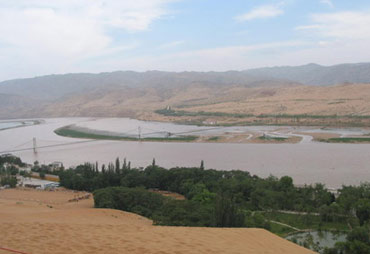Northwest China region turns desert into green land
By Han Lei (Chinadaily.com.cn)
Updated: 2006-08-26 11:07
Situated on the edge of the Tengeri Desert, the Shapotou sand control project
has been heralded as a miraculous achievement: 160,000 hectares of desert has
been turned into green land.

A integration of desert and oasis
in the Shapotou area in Zhongwei, Northwest China's Ningxia Hui Autonomous
Region, August 25, 2006.
[chinadaily.com.cn] |
As a model area for
sandstorm prevention and control project, Shapotou in Zhongwei, Northwest
China's Ningxia Hui Autonomous Region, has been transformed from a sand-stricken
area into a tourist hot spot.
The area has won world-wide recognition for its sand control efforts. In
1994, the Shapotou project was given the prestigious title of "Global 500" by
the United Nations Environment Programme for its effectiveness in stemming
desertification.
The sand control project started in 1958 when the Baotou-Lantou railway was
completed to ensure the normal operation of the railway. After years of
experiments, the technicians started to make 1m*1m square sheets with straws
before putting them on the sand. They then grew plants that can endure extremely
drought on the sheets.
Afterwards, they managed to get Yellow River water to the plants, greatly
increasing the survival rates.
With years of efforts, the ecological environment of the area has been
greatly improved. The region's experiences also set a good example for other
areas as the nation is making every effort in fighting desertification.
China has 2.64 million square km of desert land, 97.58 percent of which lies
within the seven western provinces or autonomous regions, such as Gansu, Inner
Mongolia, Xinjiang, and Ningxia, statistics show.
According to a recent figure released by the the National Development and
Reform Commission, the Chinese central government has invested more than 200
billion yuan (US$25 billion) to improve the environment in its western region in
the last five years.
The central government will further push forward ecological construction in
western regions in the coming years. Major projects will include the protection
of wetland resource and the environment along the Yellow River, Xinhua news
agency reported in its earlier report.
|